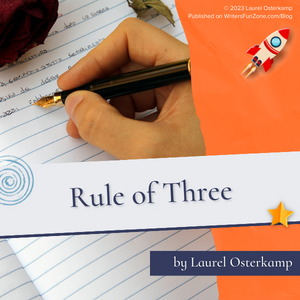Rule of Three by Laurel Osterkamp
 Let’s welcome back Laurel Osterkamp as she shares with us “Rule of Three.” Enjoy!
Let’s welcome back Laurel Osterkamp as she shares with us “Rule of Three.” Enjoy!
***
The number three is everywhere when it comes to fiction writing. No doubt, you’re aware of the three-act structure.
There’s also the comedy rule of three, the rule of three to build suspense, the technique of grouping together three elements to emphasize a point or idea, and of course, love triangles.
But what’s so magical about the number three?
Three-act structure
We almost automatically construct our stories into three acts because three acts provide a natural rhythm to a story.
The first act sets the stage and introduces the characters, the second act develops the conflict and raises the stakes, and the third act brings everything to a climax and resolves the conflict.
This structure allows for a clear beginning, middle, and end, which is satisfying for readers.
For example, Daphne DuMaurier’s Rebecca follows the three act structure perfectly.
(Major spoilers ahead.)
In act one, the unnamed narrator describes her dream, and then flashes back, and describes how she met Max de Winter, moved to Manderly, and everything went wrong.
In act two, the narrator despairs and is nearly convinced by Mrs. Danvers to kill herself. But then Max confesses to Rebecca’s murder, and he finally acts passionately toward his new wife.
Act three brings the revelation that Rebecca was dying of cancer, which absolves Maxim, but brings about questions of Rebecca’s motivations.
Then, the narrator and Maxim drive toward Manderly and see that it’s burning down.
There’s a symmetry to the story, and the well structured beginning, middle, and end is one of the reasons why this novel remains a classic.
The comedy rule of three
Watch a sitcom closely, and you’ll notice that comedic writers often use the rule of three to create punchlines.
That’s because three is the smallest number needed to create a pattern, which is essential for humor.
The first two items in the pattern set up the expectation, and the third item breaks the pattern with a surprise twist.
It’s the sudden shift in expectations that creates the humor.
A great example that breaks down how the rule works is from the movie 21 Jump Street.
The rule of three to build suspense
What is true for comedy also applies for suspense. Using three events helps to create a sense of inevitability.
The first event establishes the ticking clock, the second event raises the stakes and increases the tension, and the third event is the climax that provides the release of that tension.
Stephen King uses this rule throughout his many novels.
First, one of his characters will mention a worry or concern about something that could turn (very) problematic.
Second, that concern has several callbacks, with the tension rising all the while.
Third, and finally, the suspense peaks with intensity and there’s a climax where everything comes to a head.
Grouping together three elements to emphasize a point or idea
Literary fiction authors often see three as the ideal number for emphasis.
This technique has been used in literature for centuries, and its power creates a rhythm and flow that helps draw the reader in.
In addition, the use of three elements emphasizes the point or idea of a story more effectively than just one or two elements.
The three elements must be distinct and dynamic and bring something new to the story. If all three elements are similar, the reader might get bored and lose interest.
An example of this is found in William Golding’s classic novel, Lord of the Flies.
In this novel, Golding uses the rule of three to represent the three characters’ different ideologies. In particular, he uses a trifecta of characters — Ralph, Jack, and Piggy — to represent order, savagery, and intellect respectively.
Thus, Golding creates tension and suspense in the story as the characters clash over their different ideas.
Love triangles
With romance, three is often the magic number. The love triangle, a classic trope in fiction, is when three characters involved in a romantic situation create a natural tension that readers can’t resist.
Maybe it’s because three is the smallest number needed to create a true conflict.
One person may love another, but when a third person is added to the mix, things become more complicated.
It’s not just about two people and their feelings anymore, but also about how those feelings impact another person.
- Which person will the protagonist choose?
- Will they be able to find a happily ever after with the one they truly love?
Tayari Jones’s An American Marriage has a super-compelling love triangle. Newlyweds Celestial and Roy have a great life, until Roy is imprisoned for a crime he didn’t commit.
When Celestial turns to her childhood friend Andre for support, their friendship turns into something more. But when Roy is released from prison early, Celestial must choose between the two men.
It’s impossible to ignore the rule of three when writing fiction, whether it’s the three-act structure, or the rule of three to create conflict, build tension, or create humor.
As you’re writing, you may even be unaware that you’re using the rule of three, but its magic is undeniable.
***
About the Author
 Laurel Osterkamp is from Minneapolis, where she teaches and writes like it’s going out of style. Her short fiction has been featured in Abandon Journal, Idle Ink, Tangled Locks Literary Journal, Bright Flash Literary Journal, and The Metawoker, among other places. Her novel Favorite Daughters was released last year by Black Rose Writing, and her new novel, Beautiful Little Furies, will be released in December.
Laurel Osterkamp is from Minneapolis, where she teaches and writes like it’s going out of style. Her short fiction has been featured in Abandon Journal, Idle Ink, Tangled Locks Literary Journal, Bright Flash Literary Journal, and The Metawoker, among other places. Her novel Favorite Daughters was released last year by Black Rose Writing, and her new novel, Beautiful Little Furies, will be released in December.
Social Media:
Website – https://laurellit.com
Facebook – https://www.facebook.com/authorlaurelosterkamp
BookBub – https://www.bookbub.com/profile/laurel-osterkamp
Instagram: Laurel Osterkamp (@laurel_osterkamp) • Instagram photos and videos







Really enjoyed this article! The number three is soooo satisfying! Thanks!
Laurel, Love that you addressed so many different genres in covering the Rule of 3. Such a powerful tool to keep in mind as we write our stories. Thanks!